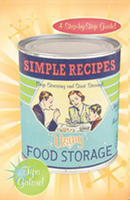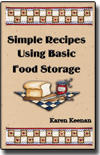

In 2008, two new food storage cookbooks were introduced – Simple Recipes Using Food Storage published by Cedar Fort, Inc. (CFI) and Simple Recipes Using Basic Food Storage by Karen Keenan. At first glance, these books looked like the same book in different formats so I bought both to compare.
The two books are, indeed, essentially the same thing. They both approach food storage with a very helpful “step” system and both provide tips for using food storage foods. They have a similar number of recipes and over 2/3 of the recipes in each book are identical to those in the other book. Some have different names but are the same recipes. The biggest differences lie in the remaining recipes (in Step 5 of both and Step 7/Part 2) and in a few other parts of both books.
What’s the same?
The “step” system these books teach helps the overwhelmed start and build a personal food storage program. Each step recommends a list of foods and then gives recipes to use those foods along with the foods in the previous step/s. The “steps” are identical in both books with only a few minor exceptions. CFI has 7 steps; Keenan has 6 steps, but her Part 2 is the same as Step 7 in CFI’s version.
Recipes in both books seem to be very doable. There is a variety, and the recipes will help you learn to use storage foods better. Both teach about sprouting and both teach about gluten but the recipes using them are different. Both books do use a lot of fresh and frozen ingredients in the last section of recipes (Step 7 and Part 2) which I tend to take issue with in a food storage cookbook. There are many recipes you would find in a typical ward Relief Society cookbook but that shows you that it’s easy to incorporate food storage foods into daily menus.
Both books need to work on recipe formatting. They both have recipes whose results would be questionable if the powdered or dried form of an ingredient was used instead of the fresh one asked for. There are also recipes (found in Step 2 of each book which recommends adding powdered eggs) that would not work with powdered eggs unless you could find dried egg yolks and dried egg whites. The use of powdered eggs in uncooked foods is also questionable from a food safety perspective.
What’s different?
The CFI version has a nice “cheat sheet” on the table of contents page to help you find all the frequently asked questions and tips since they are throughout the book and not in one place. This book has an index which lists recipes by category and main ingredients. Some recipes are listed by title, but the majority are not. The index is important in this book because the recipes in Step 7 are not grouped according to type. You could find a recipe for soup on the same page as a recipe for cookies or bean dip and have a difficult time finding it again without the index. This version has a lot of pinto bean recipes; recipes for and using yogurt; and for and using cheese made from powdered milk. CFI has also included a substitutions chart, an equivalent measures chart, and a shelf-life chart for foods that can be purchased at Home Storage Centers.
Keenan’s book puts most of the tips in the front of the book. Be sure to read through that section as it will help with the rest of the book. This book does not have an index but it has a more detailed table of contents and the recipes in Part 2 (Step 7 in the CFI book) are categorized – main dish, soup, bread, desserts, etc. One nice feature in this book is that after the list of foods recommended in each step, there is a list of recipes or dishes you can now prepare with those additional foods in your storage. Keenan also breaks down the category “spices and flavorings” in her steps. Rather than getting them all at once, she recommends a gradual accumulation according to the recipes in that section or step. That has a less painful affect on your food budget since those small items can be expensive. Keenan has recipes for soybeans in her book but also has more of the recipes you would find in a ward cookbook.
Which one?
Which should you choose? Decide if you need an index, a substitutions list, and a shelf-life chart. Would it frustrate you more not to have an index or not to have recipes categorized? Do you want recipes for yogurt, cheese, and pinto beans or do you just want some new recipes that use storable food? The basic ideas are the same in both books as are most of the recipes. It’s the differences that should help you decide which is the best for you.
